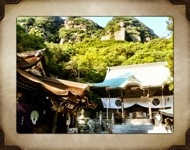Well, well, the journey slowly comes to it’s end. I’m now on the way Nagaoji (#87), which is just 5km from the Okunomiyaki-place, where I’m sitting right now. Later today I will walk towards Ōtakiji (b20), which is the last of the bengai-fudasho or bekakku temples. Together with the 88 temples it makes 108 temples, as many as mala has beats. Most people think on 108 attachments, in the context of Buddhism each beat presenting one.
What made starting thinking more deeper on attachments or bonno as they are called in Japanese, was a short event at Senyūji (#58), where I participated in the morning ceremony. As usual I was sitting in halflotus and on the end the priest told me, there is no halflotus in Shingon, only Zeza, meaning kneeling and sitting on ones heals, because this is Japanese culture. After that he was talking about attachments and of course being unaware how much he – like other people here as well – is attached to the idea, Shingon is a Japanese cultural property, what it is of course not. I didn’t reacted of course, but when I was going down the mountain, this event occupied my mind. In a glimpse of moment I got even angry about that guys ignorance. Has he ever seen Kūkai or any of the Buddha statues sitting in Zeza? Didn’t dharma teaching came from India to China and then to Japan? This lead me to thinking more about my own attachments and expectations. How can I expect that people understand emptiness, when they recite the heartsutra in Kanbun, a language, normal people don’t understand. Kanbun is actually old Chinese with Japanese pronunciation. It was used long time ago by educated people who able to read and write.
… I need to move on and will continue writing later, as I haven’t made my point yet. Please bear with me and stay tuned 😉
Thanks for your patience 🙂 I’m now just a few km away from Ōkuboji, the last temple. From there I plan to go back to Ryōzenji to close the circle.
Anyway to continue from before. What really pissed me off wad, when I was thrown off the temple ground at Kokubunji (#80) after receiving my stamp, before I could recite my mantras. They guy said that’s Japanese culture, not a bad thing with a grin in his face, saying the opposite.
After I cooled down, a voice spoke inside to me, saying do your thing in front of the gate, that’s fine. This guy will receive his fruits at one point, but it’s not your business. So I made a little incense holder, did my recitations and moved on.
What triggered anger, were my own expectations, that people do have some understanding, but they just cling as much to their social framework as I stick to my expectations. These expectations are attachment. The only thing I can change here is dropping this idea, that people at least partly share my understanding. They just don’t and they will never do. Dropping this idea means dropping this kind of attachment, opening the door to freedom and experiencing the unexpected.
And exactly that happened to me yesterday. I went up to Ōtakiji. When I got my stamp, the son of the Jushoku insisted in speaking English and told me the best option is to go and stay in a Onsen Hotel, because there’s no place with food the other way. I was thinking all the time, I’ve seen this face before… on the end, when I was about leaving, I asked him and in fact, he was studying with Sanja and we met a couple of times some 4 or 5 years ago in Kōyasan. He told me then, they will now go to that onsen and I should come with them. As I wanted to go by foot everything, I had to reject this friendly offer. The compromise was, they took my backpack with them. So these 12km downhill just took me 2 hours only. After enjoying onsen, nice food and an air-conditioned room without mosquitos, I wanted to pay my bill this morning and the guy charged me only the beer I drank the evening before. I was so surprised! Everything else was already taken care of and my heart was filled with gratefulness about this unexpected ossetai, making me again clear what kind of freedom I receive by not expecting anything 🙂
